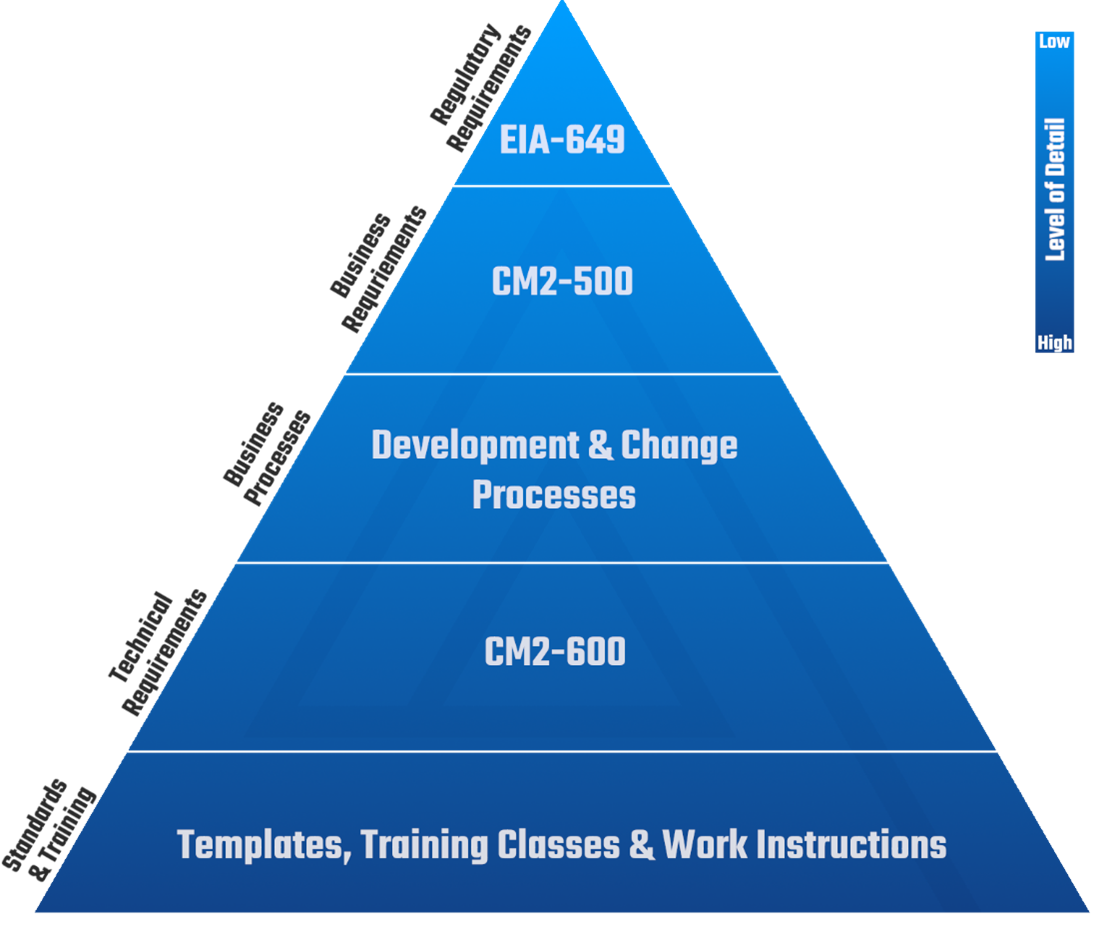June 24, 2025
IpX Director of Enterprise Systems and Processes

In today's increasingly complex and regulated environments, organizations must translate regulatory requirements into actionable business practices that drive efficiency, innovation, and compliance. For over 40 years, CM2 is a proven framework for this transformation is the CM2 model developed by the Institute for Process Excellence (IpX). By enabling ANSI/EIA-649 with CM2, organizations unlock a full-spectrum lifecycle—from meeting regulatory requirements to equipping teams through structured training.
Let’s walk through how CM2 operationalizes EIA-649, progressing from CM2-500 (Business Requirements), through Business Processes, into CM2-600 (Technical Requirements), and ultimately into the core of daily operations: Training, Standards, Work Instructions, and Tools.

EIA-649 defines the principles and practices necessary for effective Configuration Management (CM), ensuring that products and systems conform to their requirements throughout the lifecycle. This standard doesn’t dictate how to perform CM, but what needs to be achieved—traceability, control, accountability, and effective change management.
Organizations use EIA-649 to ensure regulatory compliance, reduce risks, and maintain control over system baselines. However, compliance alone doesn’t guarantee operational excellence. True operational excellence demands a structured approach that transforms adherence into strategic advantage, ensuring sustainability, agility, and continuous improvement based on tried and true best practices. This is where CM2 comes in. Organizations comply with EIA-649 but often struggle to translate compliance into strategic advantage.
While EIA-649 ensures traceability and control, true operational excellence demands more than adherence—it requires structured business alignment. This is where the CM2 framework bridges the gap, transforming regulatory mandates into actionable business strategies.
Compliance sets the foundation, but without structured business requirements, organizations remain reactive rather than strategic. This is where CM2-500 comes into play.
CM2-500 focuses on Business Requirements—strategic and operational needs that are directly derived from external mandates (like EIA-649), customer expectations, internal policy, and market drivers.
In this phase, organizations interpret EIA-649 requirements into actionable business-level policies:
This is the "why" behind the "what." CM2-500 aligns business goals with regulatory expectations, creating the foundation for organizational policies, quality objectives, and governance structures.
Once business requirements are established, they feed directly into the organization’s business processes. This is where theory turns into practice, and compliance transforms into capability.
Clear business definitions mean little without structured processes to govern implementation. The right business requirements mean nothing without a system to enforce consistency and accountability. This is where business processes take center stage, operationalizing CM2 principles to ensure repeatability, efficiency, and control.
These processes define how work gets done:
Effective business processes ensure consistency, quality, and repeatability. They are the operational embodiment of business requirements. Poorly defined processes, even with great technical plans, can undermine both compliance and efficiency. Tools alone will not provide the desired results.
Even the best-defined processes evolve. The CM2 model ensures adaptability by continuously refining business requirements as market needs shift.
Business objectives alone don’t provide engineers with the precise specifications they need to build and design correctly. Business alignment is crucial, but execution hinges on technical precision. CM2-600 translates strategic directives into tangible design criteria, ensuring that every requirement supports both business goals and regulatory expectations.
CM2-600 takes those business requirements and business processes, then translates them into detailed technical requirements. This includes:
CM2-600 ensures that engineers, developers, and system architects are building the right product, not just building the product right. It serves as the critical bridge between strategy and execution, ensuring that technical teams are aligned with both regulatory and business imperatives. This means that the off the shelf (OTS) products available such as PLM have the capability to meet the CM2 framework or best practices.
Even well-designed processes can fail if employees aren’t trained to follow them correctly or tools don’t support them. Process alone doesn’t drive excellence—people and tools do. Training, standards, and systems turn defined workflows into actionable routines, empowering teams to deliver predictable, high-quality results.
Business processes drive the creation of the tools, standards, and training necessary for day-to-day operations:
This is where organizational knowledge becomes embedded and institutionalized. Employees are empowered to deliver consistent results, manage change effectively, and continuously improve.
The progression from EIA-649 through the CM2 model creates a closed-loop system of governance and execution:
The CM2 model is not linear—it evolves as business, technology, and regulatory landscapes shift. This isn’t just a framework - it’s a dynamic system of continuous improvement. By following this structured approach, organizations don’t just comply; they innovate, adapt, and lead in a competitive landscape.
Shifts in standards or market demands don’t just trickle down - they reshape the foundation, driving essential updates to business and technical requirements. That’s the strength of the CM2 model: it transforms change into opportunity, ensuring adaptability without disruption.
By embracing this structured flow, organizations move beyond mere compliance. They lead, innovate, and evolve—turning complexity into a competitive advantage.
EIA-649 sets the foundation, while CM2 refines and expands it into a fully scalable framework for governance and execution.
I’ll leave you with this: “Compliance gets you in the game. Competence keeps you ahead of it.”

Thomas Miller is the Director of Enterprise Systems and Processes at IpX with more than 20 years of experience in enterprise systems, business processes, IT/Cyber Security, and software development within the aerospace, automotive and manufacturing industries. Thomas holds a bachelor's degree is Computer Technology with an applied area of manufacturing, a Six Sigma Black Belt for the North American region, and a CM2- Comprehensive certification.

